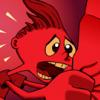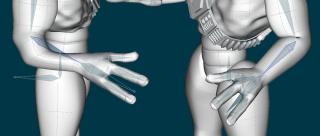-
Posts
3,775 -
Joined
-
Last visited
-
Days Won
1
Content Type
Profiles
Forums
Events
Everything posted by Gerry
-
Cronos this is all gorgeous stuff! Your models and decals are really helpful to study.
-
Amen to that! A great analogy.
-
Was this with 15.0j? P.S. Robcat, this was on a pc.
-
Wow, thank you gents. I can assure you it didn't get run through TSM rigger twice! But I did see some strange behavior when I ran Flipper, now that I think about it. I should have documented it at the time, but it made me wonder at the time if v15.0j had some compatibility probs with TSM. As I recall when I ran Flipper some bones came in with their sizes zeroed out (ie, occupying a point in space) and a text string in their size boxes, like NNaN, something like that with several N's in it. I typed in values corresponding to the original side bone and everything seemed fine, so I moved on. Rigger ran fine. I can't explain the constraint to the eyelid!! But by coincidence Robcat I only today started playing with the new filtering feature but I didn't know what I was doing so let it go. Your movie is a big help on that front too. And Mark, can I ask how many duplicate sets of constraints you found?
-
I've been looking at this for two days and I don't understand what's up here. I've installed the TSM rig numerous times with no problems but for some reason the right elbow won't deform correctly this time. I've checked the CP assignments, weighting, even deleted the fan bones I'd put in the elbows, but the problem persists. I'm posting the model and a screen shot of both elbows bent at 60 degrees for comparison. SkarabElbowProblem.zip
-
Great looking and hilarious! Music is just a nice touch!
-
Okay, 'nother question (until the next one...). I created a new MultiD relationship for the null, e.g., for the mouth corners. I didn't make it part of my face constraints pose because I wanted to be able to edit or delete it without messing with the larger constraints pose. So now in my model subfolders, inside Relationships>Bones, I've got a Null icon with the name "mouth corners", but it's above/outside the User Properties Relationships folder. It's not the Null itself because it's got Transform Relationships>Translate Relationships>X Relationships etc etc. and then the Null itself a couple of levels down.(But you knew that!) My question is, since it's outside the User Properties folder, how do I make it available in the User Properties list when I place the model in a chor? Can I just drag it into the User Properties folder? Should I have done the MultiD from inside the face constraints pose? I'm afraid if I drag it to another location in the hierarchy I'll break something. But as it is now I don't know how to activate it.
-
One thing I keep encountering that I think should be mentioned is that for some reason, when I create the translate limits after creating the MultiD relationship, is that the translate limits defaults to an enforcement of zero. It was driving me crazy until I remembered to look for it. Otherwise I'm having fun with this.
-
Hey Holmes - I've been digging into the LiteFace rig to try to gain some understanding, as I need to rig a non-standard face (Skarab) and I think the *easiest* way will be to build a face rig from scratch. So I thought I'd ask these questions here rather than by email so others may either learn something, or teach me something! What I'd like to understand, which I haven't been able to figure out after spending the last 2-3 hours digging through the various constraints, is how, e.g., the "Mouth Corners Master" null will move the "Mouth L Corner Control" null in one direction, and the "Mouth R Corner Control" null in the opposite direction, resulting in the mouth forming symmetrical shapes. I notice this is crucial for several of the controller nulls. At first I was looking for a constraint, but then noticed that both Corner controllers are children of the Corners Master, so constraints wouldn't be possible, right? But I can't figure out how the one moves in the opposite direction.
-
One more solution for selecting the five points is to position the model so you can "lasso" just the five points. that will sometimes activate the 5-point patch tool when shift-selecting the 5 cp's separately doesn't.
-
Can't you constrain to surface? Or is that the same thing you're trying to do?
-
Gorgeous but I think the patty needs maybe a displacement or something to give the edge some texture. It's a little too perfect and elliptical. Maybe just pull some cp's on its mesh if the mesh is dense enough.
-
that material effector tute is really great! but your lightning bolt can be accomplished in a number of ways; animating a gradient is probably the *simplest*. EDIT: Hey Gene, it just occurred to me after watching your test mov's that you might search YouTube for videos of lightning flashes. Maybe you have already...but the way you have yours blinking on and off, I think there's more subtlety in the real thing if you want to refine it. The animated material would be the way to go.
-
I'm going to add a little something to Robcat's reply that won't be redundant. but it also won't be comprehensive, and anyone else please jump in to correct me. Windows: You create a model in a modeling window. You can set the surface properties in the modeling window by creating and naming groups from parts of the model. You also insert bones in the modeling window, by entering Bones mode. This is also where you attach the geometry to the bones. You create reusable actions, in an action window, including walk cycles; applying decals can be done in the model window but they can be applied more easily in an action window because you can move the cp's around without affecting the actual geometry. This is a super flexible process once you have a handle on it. there are some excellent tutorials on decaling; Will sutton has a whole YouTube channel for his tutorials and they're worth spending some time on. When you create an action it's extremely helpful to name them as you go, so you don't end up with Action 1, Action 2, Action 3, etc., without having a clear idea of what each is. You create a material in a material window (the sphere on the checkerboard) but it's often better, once you've started (and named) the material, to drop it on the model or group you're creating it for. It's easier to understand/visualize the material attributes and scale once it's on the model. It's less obvious if you're just looking at the sphere. Once you have it placed on a model or group, you can generally close the material window. Lastly, all actual animation is done in a choreography window. this is where you set up cameras, lights, drop in your models and characters, and tell your story. When you render a scene, it will render from whatever view you were last looking at; what I mean is, it doesn't automatically render from the camera's viewpoint, you have to be looking through the camera (1 on the number pad) to render from the camera. this is just a quick rundown off the top of my head. I hope it helps! Like any 3D app there's a steep learning curve; hang in there and come here with questions.
-
You can drop cameras into a chor anytime you like. You switch among them by hitting the 1 key on the keypad, it cycles among the various cameras. then select the camera you want to render from, render the frames you need, then render additional frames from the next camera you want. You'll need to composite them in post, which can be done right in AM or with another app like QuickTimePro or After Effects. To aim the camera at a character: In the chor, right click on the camera, select new constraint, and choose "aim at", and use the resulting eyedropper to select the character. You may need to adjust the offsets, as the camera will aim at the model bone which is often at foot-level. But just adjust the Y-offset to focus the camera on the head, face, etc. These are both simple operations. Good luck! Come back with any questions.
-

Representing action movement with blur
Gerry replied to Eric2575's topic in Work In Progress / Sweatbox
Wow, that's great! I've never seen a flower pot move like that! or spittoon...? -
I take it this is the Captain, David? Very nice head! the angle of the jaw seems a little severe in relation to the jowls and cheekbones. You might consider simplifying the forms around that area. but in sum a nice job! I don't remember if I've responded to your last animatic. I watched it and liked it. If I haven't written I will soon. (believe it or not I'm at the office at 9:00 on a sunday night!)
-
Can you specify a thinner line depending on the transparency? Also, what about changing the toonline bias? Just guessing. The other solution is what paradymx suggested, render a separate file for the lines and composite, but it would be nice to find a solution inside A:M!
-
Hey Jason, that illustration about the zero depth for displacement maps was a big help. I was having a heck of a time just the other day "cheating" a zero depth because I assumed it would be 128. It ain't!
-
I may be misremembering. I'll look into it and let you know.
-
Hey Robert- I believe you can indeed drag materials nodes into different hierarchies in the pws to get different layering effects. I haven't tried it myself but in the Anzovin materials tutes I know it's done.
-
Happy Birthday David!









